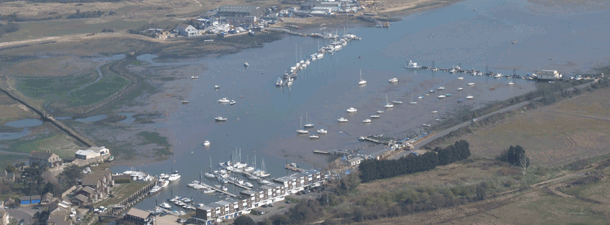Bembridge Harbour, the only sheltered natural harbour on the east coast of the Isle of Wight, has been put up for sale. Vail Williams LLP, leading real estate advisers, are acting for the Administrators, RSM Tenon.
The attractive and historical harbour at Bembridge has played a key part in the history of the Solent ever since it was a port for the Romans. Today it is extremely popular with sailors and tourists, providing around 600 berths on pontoons and buoyed moorings.
Offering sheltered waters throughout its history, Bembridge was known in the Medieval period for exporting stone and as a fishing port. In 1545 the French navy invaded Bembridge and burnt the village, prompting the English fleet to leave Portsmouth intending to defend the Isle of Wight. The Mary Rose was one of the ships leaving Portsmouth and she didn’t travel far before she sank, which led the English navy to retreat, leaving Bembridge to burn. The French left Bembridge shortly afterwards.
For Charles I, Bembridge harbour was the principal port for the Island and the seaward area just outside Bembridge Harbour was the departure point for Nelson’s fleet in 1805 as it headed off to Trafalgar. In Victorian times the first ferry steamer was set up to carry passengers to and from Portsmouth.
In 1864 a Pier was built and Bembridge Harbour was dredged and larger ships started to visit. The arrival of the railway in the nineteenth century transformed Bembridge Harbour into a busy industrial landscape, although when the railway closed in 1953, much of the associated buildings and industry moved away. In 1963 the Bembridge Harbour Improvements Company was set up and the focus of the harbour moved towards tourism and catering to the needs of the growing number of cruising sailors.
Today, Bembridge Harbour covers land and water space totalling over 150 acres. The property and business are for sale as a going concern, and will include the transfer of Statutory Harbour Authority Powers. The Harbour has 380 directly managed moorings in Bembridge Marina, on three floating pontoons and on up to 108 buoyed trot moorings which are used during the summer season. The harbour pontoons maintain a minimum depth of at least one metre at low water and the harbour is accessible for about two and a half hours either side of high water.
On land, the principal areas for sale include the harbour office and workshops on the Duver peninsular, including berth holders showers, a toilet block and office or shop premises. Land and buildings around Bembridge Marina and holdings along Embankment Road include an area set aside for depositing material dredged from the harbour.
The Harbour receives income from annual and seasonal licences of pontoon and trot moorings and there are also 18 commercial leases and licenses in place giving a gross income of around £527,000 in the year to March 2011. The Pier & Harbour Order (Bembridge Harbour) Confirmation Act 1963 vests power in the owner of the harbour to lay moorings and build structures as well as dredge the harbour and its approach channel. The owners also enjoy the status of a Statutory Harbour Authority.
The freehold and long leasehold interests together with the trading goodwill as a going concern are for sale. The existing employees would be retained under TUPE regulations.
Sandy Kinninmonth for the Joint Administrators commented: “Bembridge Harbour has enormous potential and the sale will open up all sorts of exciting possibilities for a new owner. With a new lease of life, the Harbour will be a sound investment for the right purchaser.”
Ian Froome of Vail Williams LLP commented: “Bembridge Harbour is in a very attractive location and is hugely popular within the marine leisure community both as a base and as a place to visit. With good facilities and an established business, the harbour is a valuable investment opportunity.”






















